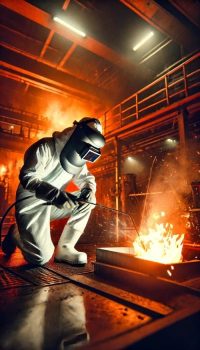Understanding FR Protective Clothing
Fire safety is a cornerstone of personal protection in many industries. In the market, FR protective clothing offers critical safety solutions. The term “FR” in protective clothing can stand for either “Flame Retardant” or “Fire Resistant.” While these terms might sound similar, they represent distinct approaches to fire protection, each with its own characteristics and applications. This article dives into fire safety, explaining the differences between these terms and guiding you towards the best option for your needs.
What is Flame Retardant?
Flame retardants are chemicals added to materials or applied as treatments to slow down or inhibit the spread of fire. Flame retardants can be applied to a wide range of materials, from woven fiber, nonwoven fabric to plastics and certain metals. However, it’s important to note that flame retardants do not render materials completely fireproof. Instead, they save precious time by slowing flame spread, potentially allowing for evacuation or the implementation of fire suppression measures.
The flame retardant protective clothing refers to any garments that are specifically designed to protect the wearer from flames and thermal injury. Flame retardant material resists ignition and self-extinguishes once the source of the ignition is removed. This helps to prevent burns from both initial exposure to the flames and from residual heat transfer.
When considering the use of flame retardant protective clothing, several factors must be taken. The effectiveness of these treatments can vary significantly depending on the fabric material, the specific chemical used, and the intensity of the fire. Additionally, the durability of flame retardant treatments is a key consideration, as their effectiveness can diminish over time. While flame retardant protective clothing is a valuable tool in fire safety arsenal, it should be viewed as part of a comprehensive fire safety strategy rather than a standalone solution.

Pic 1: The front line worker at fire hazard environments should all wear FR protective clothing.
What is Fire Resistant?
Fire resistant materials are inherently resistant to burning and designed to withstand heat and fire for a specified period. These materials are engineered at a fundamental level to withstand heat transit, resist ignition, prevent fire spread, and maintain structural integrity under certain temperature conditions. This resistance is an inherent characteristic of the material itself, not due to external chemical treatments.
The fire resistant protective clothing, on the other hand, is constructed from materials that meet the specific fire resistance requirements. There are various forms of fire resistance clothing each designed to address specific needs and also have to meet fire safety standards. It is ideal for environments with a high risk of fire and where the highest level of protection is required.
In extreme scenarios, such as electrical work, Arc Rated clothing offers protection against arc flash hazards. There is a term “AR” (Arc Rated) named to easier understanding for employers and consumers to identify if the clothing offers sufficient protection. AR clothing protects the wearer from electrical arc flash hazards which is a quick but lethal that release massive amounts of deadly energy. Within a fraction of a second, they can reach over 19,000°C and cause fatal burns and ignite and vaporize nearby objects.
Key Differences
- Material: Flame retardants are applied as coatings or treatments, while fire resistance is an inherent property of the materials.
- Durability: Flame retardant treatments may lose effectiveness over time, whereas fire resistant properties are typically permanent.
- Heat Protection: Fire resistant materials generally offer a higher level of protection and can withstand fire for longer periods.
- Cost: Fire resistant materials are often more expensive due to their specialized composition and manufacturing processes.
Which Option Is the Best?
The ideal choice between flame retardant and fire resistant protective clothing depends on the specific requirement of situation. If the primary concern is preventing a fire from starting in the first place, then a flame retardant protective clothing may be the best choice. It can resist ignition and slow the spread of fire, which can help prevent a small fire from turning into a large one. On the other hand, if the material is likely to be exposed to high temperatures or direct flames, then a fire resistant protective clothing may be more appropriate.
Choosing between flame retardant and fire resistant clothing depends on various factors specific to each application. Here’s a breakdown to help you decide:
When to Choose Flame Retardant:
- Modifying the inherent properties of a material is impractical.
- Buying time for evacuation or fire suppression is crucial.
- The potential fire source is low intensity.
- Weight and cost limitations exist.
When to Choose Fire Resistant:
- Containing a fire within a designated area is critical.
- Structural integrity during a fire needs to be maintained.
- The potential fire source is high intensity.
- Long-term protection and durability are paramount.
Conclusion
Both flame retardant and fire resistant protective clothing play vital roles in fire safety. Understanding their differences helps making informed decisions to ensure maximum protection against fire hazards.
The right choice can significantly enhance worker safety in fire-risk environments. Flame retardants can buy valuable time, while fire resistant materials can contain a fire and protect structural integrity for frontline workers. Always consult with safety professionals and conduct thorough testing before implementing new FR clothing in your workplace.

